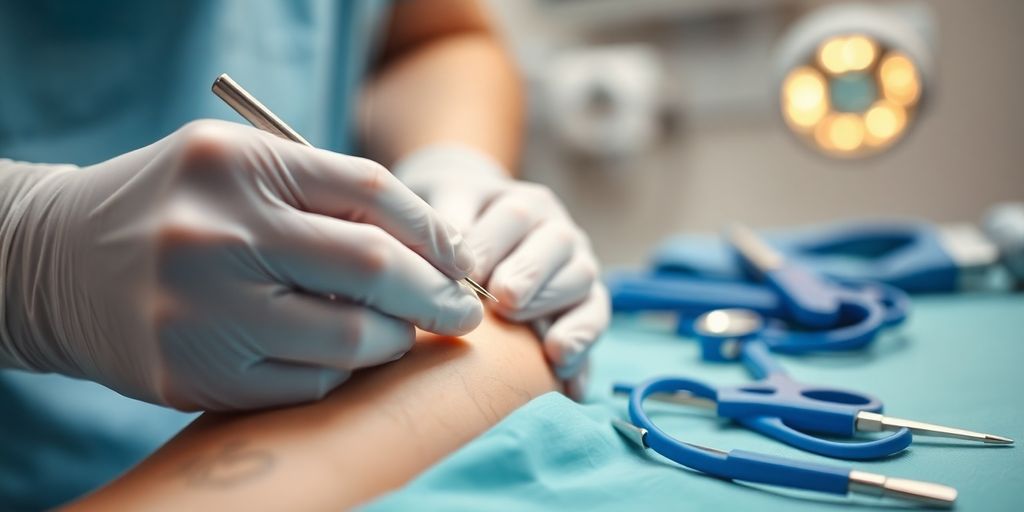If you find yourself with a cut that might need stitches, knowing where to go for treatment can make a big difference. Urgent care clinics are often the best option for getting quick and effective care without the long wait times and high costs of an emergency room. This article will guide you through understanding when to seek stitches, the benefits of urgent care, and how to find the right clinic for your needs.
- Where to Sell Pokemon Cards Near Me: Finding the Best Local Options
- Discover the Most Aesthetic Cafe Near Me: A Journey into Cozy Vibes and Beautiful Brews
- Discover What Are They Building Near Me: A Guide to Local Construction Projects
- Discover the Best Pet Farm Near Me: A Guide to Local Petting Farms and Zoos
- Discover Where Is The Chosen Playing Near Me: Your Guide to Local Showtimes
Key Takeaways
- Urgent care is ideal for non-emergency wounds needing stitches.
- Look for signs like persistent bleeding or jagged edges to determine if stitches are needed.
- Urgent care clinics offer quick service, often with shorter wait times than ERs.
- Not all cuts need stitches; some may be treated with alternatives like Steri-Strips.
- Always clean a wound properly and seek medical help if you’re unsure about its severity.
Why Urgent Care is Ideal for Stitches
When you have a cut that needs stitches, urgent care is a great option. These clinics are designed to handle minor injuries quickly and efficiently. Here are some reasons why urgent care is perfect for stitches:
Benefits of Urgent Care for Stitches
- Quick Treatment: You can often be seen without an appointment.
- Extended Hours: Many urgent care clinics are open evenings and weekends.
- Less Stress: Avoid the long waits often found in emergency rooms.
When to Choose Urgent Care Over ER
- If the cut is not life-threatening.
- If you can apply pressure and the bleeding is manageable.
- If the injury is not on the face or involves deep tissue.
Cost Comparison: Urgent Care vs. ER
| Service Type | Average Cost |
|---|---|
| Urgent Care Visit | $100 – $200 |
| Emergency Room Visit | $500 – $3,000 |


Urgent Care Availability and Hours
- Most clinics are open 7 days a week.
- Many have extended hours, making them accessible when you need them most.
Urgent care clinics can efficiently handle minor cuts and wounds needing stitches. They are equipped for such injuries, avoiding the stress of an emergency room visit.
Signs You Need Stitches
When you get a cut, it can be hard to tell if you need stitches. Here are some signs to help you decide:
Identifying Serious Cuts
- Deep or jagged cuts: If the cut is deep, long, or has jagged edges, it likely needs stitches.
- Bleeding that won’t stop: If your cut keeps bleeding after applying pressure for 10 minutes, seek medical help.
- Location matters: Cuts on the face or joints often require stitches to heal properly.
When to Seek Medical Attention
- If the cut is over ½ inch long.
- If you can’t push the edges of the cut together.
- If the cut is from a bite or has debris in it.
Common Injuries Requiring Stitches
- Cuts from sharp objects like glass or metal.
- Lacerations from falls or accidents.
- Cuts on sensitive areas like the face or hands.
First Aid Before Getting Stitches
- Clean the wound gently with soap and water.
- Apply a clean cloth to stop the bleeding.
- Keep the area covered until you can see a doctor.
Remember, if you’re unsure whether you need stitches, it’s always best to consult a medical professional. Better safe than sorry!
Urgent Care Services for Wounds
When you have a cut or wound, urgent care clinics are a great option for treatment. They provide quick and effective care without the long waits often found in emergency rooms. Here’s what you can expect:
Cleaning and Preparing the Wound
- Assessment: The medical staff will first assess the wound to determine the best course of action.
- Cleaning: They will clean the wound thoroughly to remove any dirt or debris.
- Preparation: After cleaning, the area will be prepared for stitches if needed.
Types of Stitches Used
- Absorbable Sutures: These dissolve on their own and don’t need to be removed.
- Non-absorbable Sutures: These need to be taken out after the wound has healed.
- Staples: Often used for larger wounds, especially on the scalp or torso.
Alternatives to Stitches
- Skin Glue: For small cuts, medical adhesive can be used instead of stitches.
- Steristrips: These are adhesive strips that hold the edges of a wound together.
- Bandages: Sometimes, a simple bandage is all that’s needed for minor wounds.
Urgent care clinics can handle many types of wounds, ensuring you get the right treatment quickly. If you’re looking for urgent care near me, you can find reliable treatment for cuts and wounds at your local clinic.
Follow-Up Care and Removal of Stitches
- Follow-Up Appointments: It’s important to return for a check-up if your wound is stitched.
- Suture Removal: Non-absorbable stitches usually need to be removed within 5-14 days, depending on the location of the wound.
- Monitoring for Infection: Keep an eye on the wound for any signs of infection, such as increased redness or swelling.
Choosing the Right Urgent Care Clinic
When you need stitches, finding the right urgent care clinic is important. Choosing the right clinic can make a big difference in your care. Here are some key factors to consider:
Factors to Consider
- Location: Look for clinics that are close to your home or workplace.
- Services Offered: Ensure the clinic provides stitch services and other wound care.
- Staff Qualifications: Check if the medical staff are experienced and certified.
Reading Reviews and Testimonials
- Online Reviews: Look for patient reviews on websites like Google or Yelp.
- Word of Mouth: Ask friends or family for recommendations.
- Ratings: Pay attention to overall ratings and specific comments about care quality.
Insurance and Payment Options
- Insurance Coverage: Verify if the clinic accepts your insurance plan.
- Payment Plans: Inquire about payment options if you are uninsured.
- Cost Transparency: Look for clinics that provide clear pricing information.
Finding Nearby Urgent Care Clinics
- Use Online Maps: Search for urgent care clinics using Google Maps.
- Check Local Listings: Websites like Yelp can help you find nearby options.
- Ask Your Doctor: Your primary care doctor may recommend a good clinic.
Finding the right urgent care clinic can help you get the care you need quickly and effectively. Remember, if you have a minor fracture, deep cuts requiring stitches, severe sprains, or burns that are not life-threatening, urgent care is the right choice.
When to Visit the Emergency Room Instead
Severe Bleeding and Deep Wounds
Read More : Discovering Tasty Food Near Me: A Culinary Adventure in Sacramento
If you have a cut that is bleeding heavily and does not stop after applying pressure for 10 minutes, you should go to the emergency room. Here are some signs that indicate you need immediate care:
- Blood spurting from the wound
- The cut is deep, exposing fat or muscle
- The injury is on your abdomen or chest
Cuts with Embedded Objects
If there is a foreign object stuck in your wound, it’s crucial to seek emergency help. Trying to remove it yourself can cause more damage. Always let a healthcare professional handle it.
Facial and Joint Lacerations
Cuts on the face or over joints can be serious. They may require special care to minimize scarring or ensure proper movement. If the edges of the cut open when you move, it’s time to visit the ER.
Signs of Infection or Complications
If you notice signs of infection, such as increased redness, swelling, or pus, you should seek medical attention. Ignoring these symptoms can lead to serious complications.
Remember, if you’re ever in doubt about the severity of your injury, it’s better to be safe and get checked out. Your health is the priority!
Preventing Wound Infections
When you have a cut, it’s important to keep it clean to avoid infections. Your skin is your first line of defense against germs, and a wound can let bacteria in. Here are some tips to help prevent infections:
Proper Wound Cleaning Techniques
- Wash your hands thoroughly before touching the wound.
- Rinse the cut gently with clean water to remove dirt.
- Use mild soap around the area, but avoid getting soap directly in the wound.
Recognizing Signs of Infection
- Redness or swelling around the wound.
- Increased pain or tenderness.
- Pus or other drainage coming from the cut.
Importance of Tetanus Shots
- Make sure your tetanus shot is up to date, especially if the wound is from a dirty object.
- Tetanus shots are usually recommended every 10 years.
Keeping your wound clean and monitoring it for signs of infection is crucial for healing. If you notice any unusual symptoms, seek medical help right away.
When to Follow Up with a Doctor
- If the wound does not heal after a few days.
- If you see any signs of infection.
- If you have any concerns about your wound.
By following these steps, you can help ensure your wound heals properly and reduce the risk of infection. Remember, prevention is key!
Understanding the Stitches Procedure
When you need stitches, it’s important to know what to expect. Getting stitches is a common procedure that helps your body heal. Here’s a breakdown of the process:
What to Expect During the Procedure
- Cleaning the Wound: The doctor will clean your cut to remove any dirt or debris.
- Numbing the Area: A local anesthetic will be applied to make sure you don’t feel pain during the procedure.
- Stitching the Wound: Using a small needle and thread, the doctor will sew the cut closed. You might feel some pressure, but it shouldn’t hurt.
Pain Management and Anesthesia
- Local anesthetics are used to numb the area.
- You may feel some tugging but no sharp pain.
- If you feel discomfort, let your doctor know right away.
Types of Sutures Used
| Type of Suture | Description | Removal Needed? |
|---|---|---|
| Absorbable | Breaks down naturally in the body | No |
| Non-absorbable | Needs to be removed by a doctor | Yes |
Post-Procedure Care Instructions
- Keep the area clean and dry.
- Follow your doctor’s advice on when to return for stitch removal, usually between 3 days to 3 weeks after surgery.
- Watch for signs of infection, such as redness or swelling.
Remember, proper care after getting stitches is crucial to avoid complications and ensure a smooth recovery. If you have any concerns, don’t hesitate to reach out to your healthcare provider.
Final Thoughts on Finding Urgent Care for Stitches
Read More : Discover the Ultimate Shopping Store Near Me: Your Guide to Local Retail Gems
In conclusion, if you find yourself with a cut that might need stitches, urgent care clinics are a great option. They offer quick and affordable treatment without the long waits often found in emergency rooms. Remember to look for signs that indicate you need stitches, like persistent bleeding or jagged edges. Even if your wound doesn’t need stitches, it’s wise to get it checked out, especially if it’s dirty or deep. Always prioritize your health and don’t hesitate to seek help when you need it. Finding the right urgent care near you can make all the difference in getting the care you need.
Frequently Asked Questions
What should I do if I get a cut that might need stitches?
If you have a cut that keeps bleeding after 10 minutes of applying pressure or looks deep, you should visit an urgent care clinic for evaluation.
How do I know if I need stitches?
You might need stitches if your cut is jagged, more than half an inch long, or if it’s on a joint and the edges don’t stay together.
Can I go to urgent care for stitches instead of the ER?
Yes, urgent care is a great option for many cuts that need stitches, especially if they are not very deep or serious.
What happens during the stitches procedure?
The doctor will clean your wound, numb the area, and then use a needle and thread to sew the cut closed.
How long do stitches stay in?
Stitches usually stay in for about 7 to 10 days, but your doctor will tell you when it’s time to remove them.
What should I do if I think my stitches are infected?
Look for signs like increased redness, swelling, or pus. If you notice these, contact your doctor right away.
Soure: https://herego.net
Category: near me


